Which Roses Can You Grow In Pots? These Growers Share Their Secrets For Success

PERENNIALS > ROSES > CONTAINERS
Chris is a gardening writer and nature enthusiast. He graduated from Oxford Brookes University in 2022 with an MA in Psychology. Chris works with the Leeds Green Action Society, helping their food cooperative by growing various fruit and vegetables on their two allotments in Hyde Park, Leeds.
Reviewed By COLIN SKELLY

Colin is a Horticulturist and Horticultural Consultant with experience in a range of practical and managerial roles across heritage, commercial and public horticulture. He holds the Royal Horticultural Society’s Master of Horticulture award and has a particular interest in horticultural ecology and naturalistic planting for habitat and climate resilience.
Contributions From EMILY CUPIT

Emily is a Gardening Writer, Photographer and Videographer from Derbyshire, UK. She is the Founder of Emily's Green Diary - a community of more than 75,000 people who share in her gardening journey.

Ben has been a professional gardener for over 20 years and is currently the nursery manager at Country Garden Roses. Country Garden Roses has been established for 35 years and is based at Black Birches in Shropshire, home to 500 different varieties of rose. The nursery has won several RHS medals, including Silver Gilt awards at the Shrewsbury Flower Show.

As the Owner of Dickson Roses, a specialist nursery, Colin bred roses from 1977-2018, marking the end of the nursery’s 140-year tradition. Despite this, Colin still won Rose UK’s Rose of the Year award in 2022 for his rose ‘It’s A Wonderful Life’ - the 8th time Dickson Roses has received that particular accolade, which is lauded by the RHS.

A Partner at Style Roses, Chris has worked in garden rose production for over 40 years and is the former Production & Marketing Manager for the Horticultural Department of Lincolnshire Field Products. Chris opened up his specialist nursery Style Roses in 1999 operating from Lincolnshire, specialising in standard and bush garden roses sold bare-root - and currently offers over 400 varieties of garden roses for sale.

With over 45 years as a Co-Owner of Harkness Roses, Philip has made a name for himself in the rose industry. His plant nursery won gold medals at the Chelsea Flower Show in 2021 and have bred various new roses, including ‘The Duke of Edinburgh’ rose, which was handed to the Late HRH Queen Elizabeth II to commemorate what would have been her late husband’s 100th birthday.
IN THIS GUIDE
ROSE GUIDES
Climbing Varieties For Shade
Common Problems
– Sawfly
– Black Spot
– Yellowing Leaves
Feeding
Growing In Containers
Pruning
– Pruning Climbing Roses
Taking Cuttings
Training
Red Varieties
Roses are wonderful plants, and perhaps the most famous flower in the world.
Whether your knowledge of roses stops at the single deep red flower held between the teeth of thousands of silver-screen romantic heroes, or extends to the hundreds of cultivars available – an endless rainbow of colours, shapes, and sizes – there’s no denying that they’re something special.
If you don’t have the luxury of a large garden with beds for planting and tending flowers, then fear not: growing your own roses is still a possibility.
Thankfully, many rose varieties can be grown in pots, giving you the chance to grow roses from your patio, balcony, or even windowsill!
Which Roses Can I Grow In Pots?
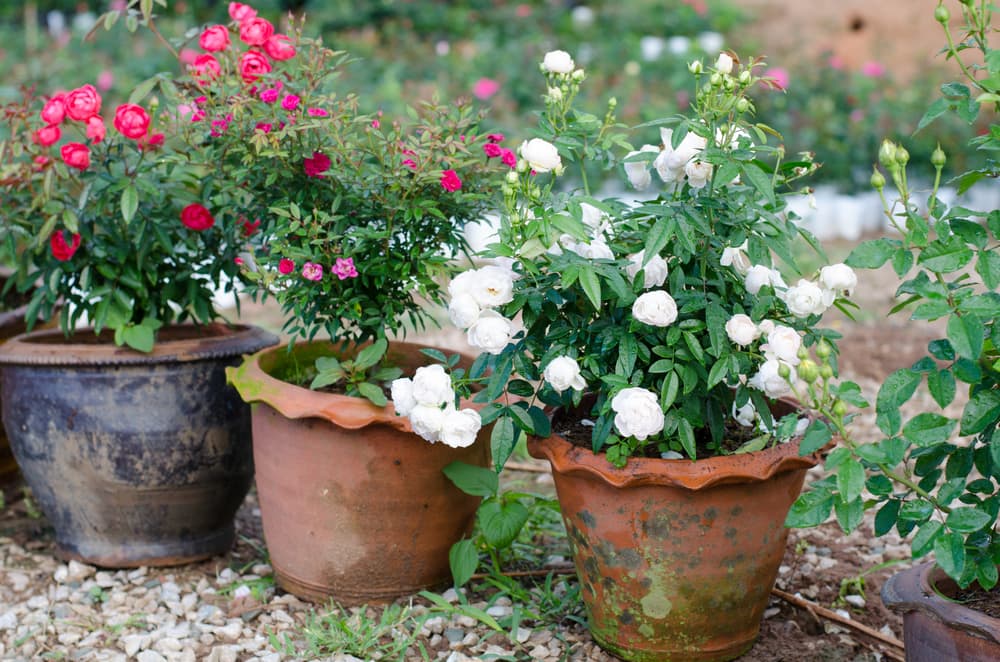
When choosing to grow roses in a container, you need to take special care.
Certain varieties aren’t suited at all to container growth, and others require certain conditions to be able to thrive.
“I wouldn’t recommend keeping hybrid tea varieties, large Shrub roses or large climbers in containers, as these have an extensive root run and would get stressed being kept in a small space,” says Ben Stirton from Country Garden Roses.
As a rule, avoid rambling roses – these are prone to quickly outgrow the confines of a pot, and prefer to be grown in the ground.
“Make sure you buy a container large enough to allow the roots to spread and the rose to grow,” advises Colin Dickson, when asked about container care.
“Yes, any rose can be grown in a container, but the larger the rose, the bigger the container,” adds Chris Styles from Style Roses.
“Choose a heavy, frost-resistant or heavy wooden pot to give weight and support at the base.”
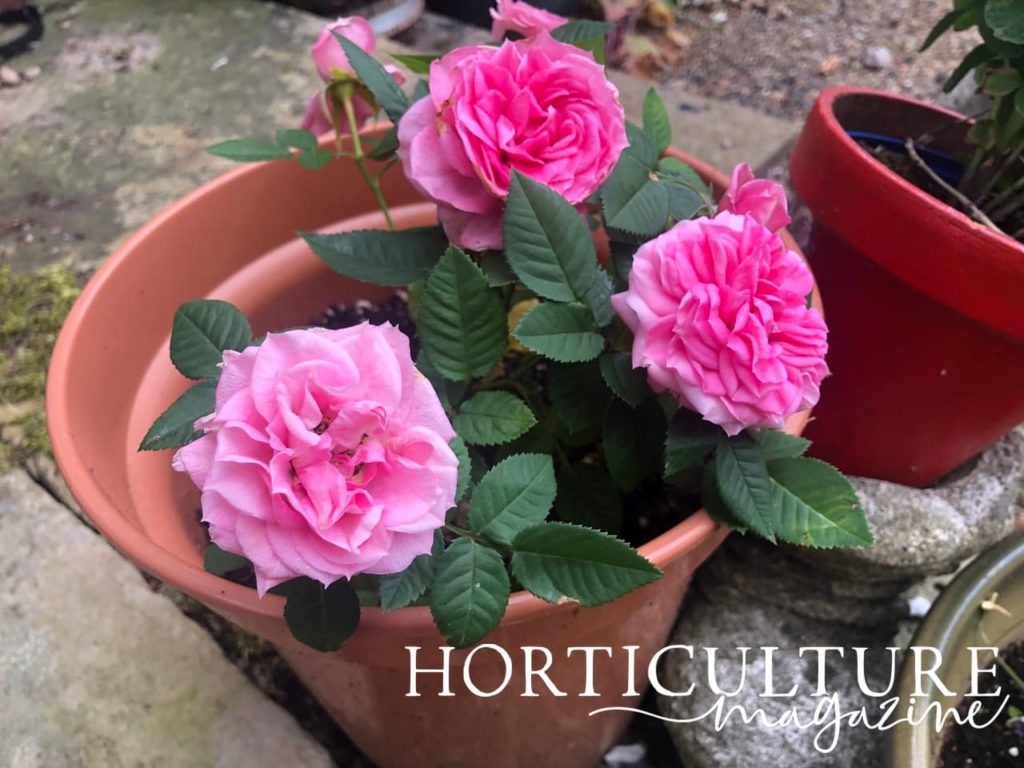
Below you’ll find a selection of rose cultivars suited for various pot sizes.
Each of the suggestions below has been awarded the Royal Horticultural Society’s Award of Garden Merit, indicating a plant that will grow particularly well in British gardens.
Miniature Roses

Cultivars in this category are bred specifically for pots, with smaller root systems, less enthusiastic growth, and a smaller overall size.
Varieties like Rosa Anna Ford ‘Harpiccolo’ are great examples.
The bright crimson flower with mottled orange colouration packs a bold punch for its size, and is a perfect showcase of the character and vitality roses can bring to your garden.
These roses lend themselves best to pots with a diameter and height of at least 30cm each.
Standard Roses
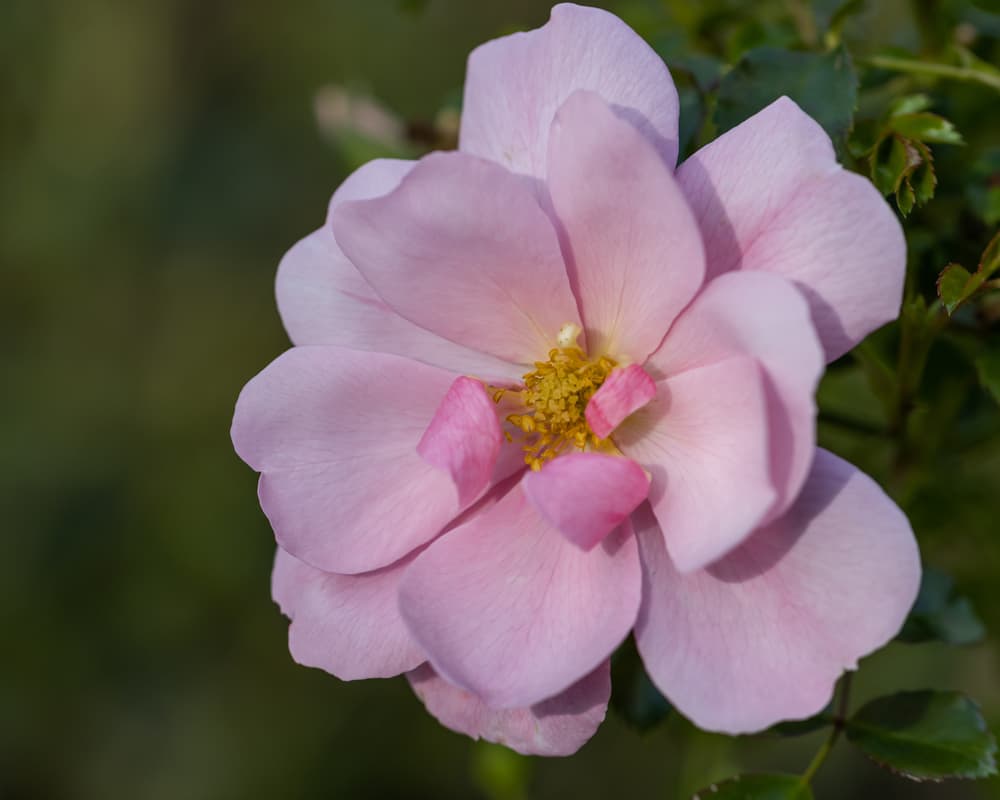
The tumbling white-pink bloom of the Rosa Queen Mother ‘Korquemu’ cultivar (pictured) will look charming in any container, and with a height of 0.5m, overall it’s not too imposing.
Standard roses align best with the general conception of what roses should look like, although there is still a large amount of variety within these cultivars.
Ground Cover Roses
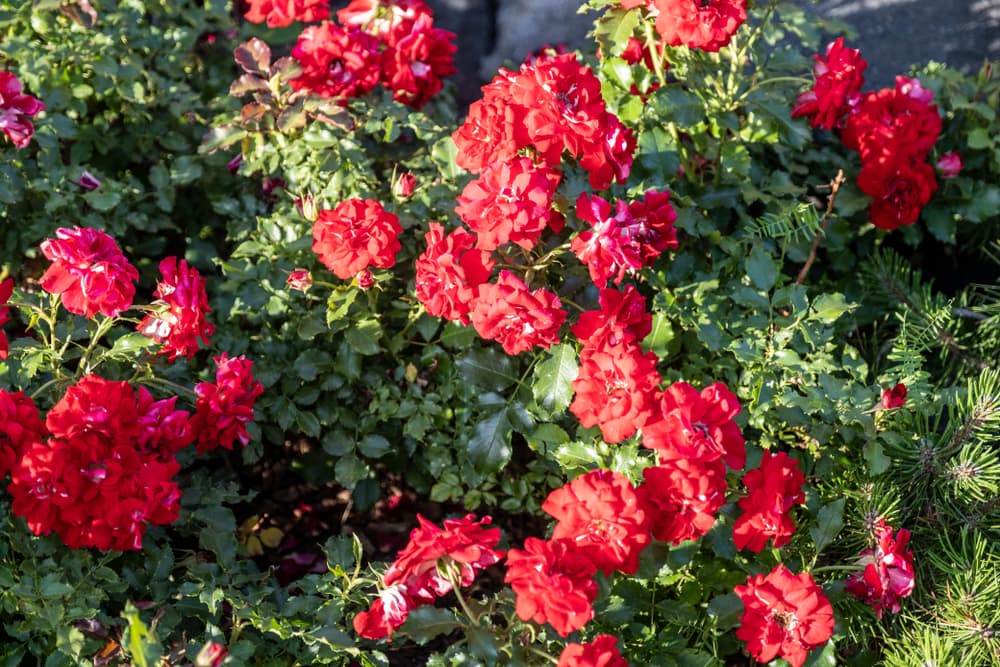
Rosa Berkshire ‘Korpinka’ is a fine example of a ground cover rose that can be encouraged to grow in a pot.
The attractive, deep pink flowers with their pretty white centres are an inviting addition to any garden.
This type of rose will be fairly low, reaching a height of about half a metre: ideal for a container in a spot where you don’t want too much vertical obstruction.
When growing shorter climbing roses, use a pot with a diameter and height of at least 45cm to give them ample space to grow.
Shorter Climbing Roses

“There are a good selection of patio climbing roses that are happy in a container and can be kept compact by pruning well,” explains Ben.
Varieties like Rosa ‘Phyllis Bide’ are suitable for growing in containers.
Boasting pink and white flowers with bold streaks of yellow and even orange, these relatively thorn-free roses will make a beautiful addition to your outdoor space.
As with ground cover roses, shorter climbing roses will do best in pots with height and diameter of at least 45cm.
Larger Roses
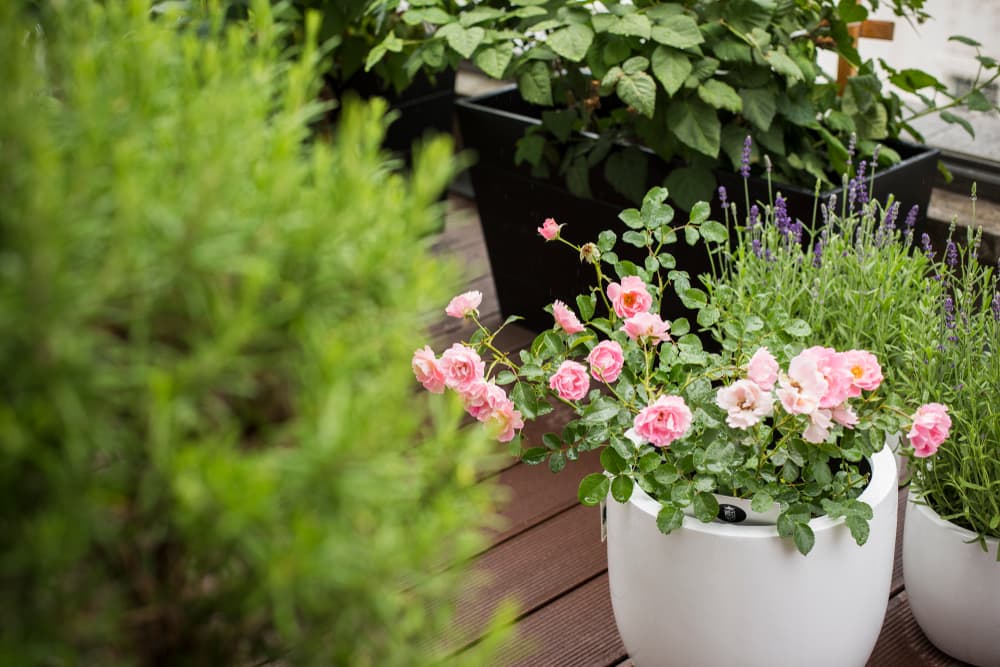
It’s possible to grow other types of roses in pots, but you’ll need to invest in a container with diameter and height of at least 60cm to give your plant a realistic chance at healthy growth.
Roses suitable to this type of growth include shrub, bush, and climbing varieties.
“If you use a big pot, don’t be afraid of adding a few companion plants or popping some bulbs in for early season colour,” says Philip Harkness, the Co-Owner of Harkness Roses.
“The rose is sociable and it will not sulk if it has to share space.”
Which Compost Should I Use?
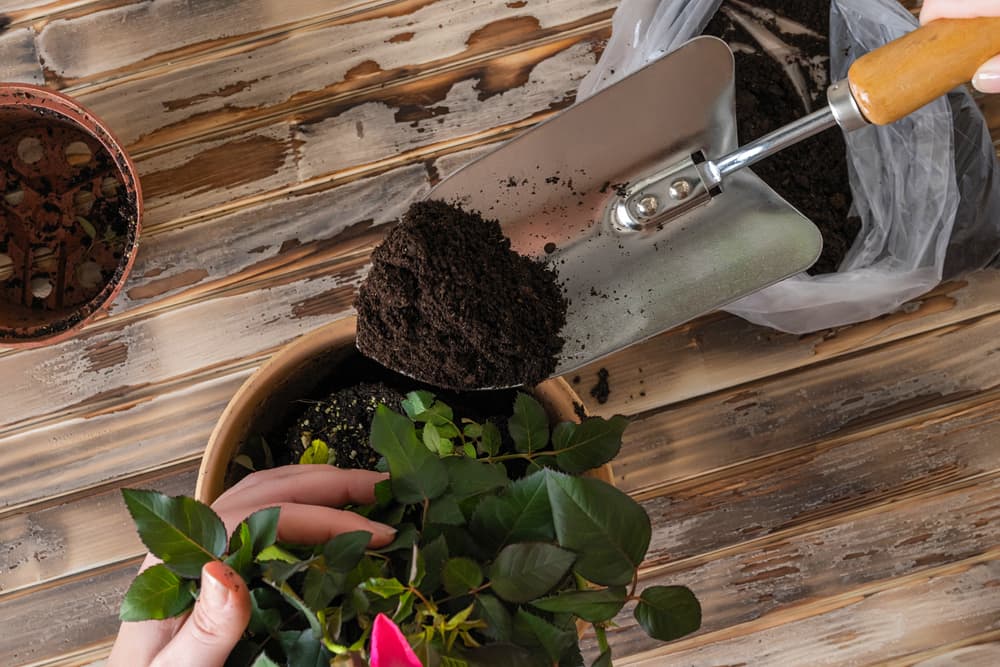
When growing roses in pots, go for something loam-based.
This will keep conditions moist and hold a good amount of nutrients, giving your roses a solid foundation for growth.
“Always use a John Innes No.3 compost as the growing medium,” suggests Chris.
John Innes 2 will also work.
You can add multi-purpose compost or manure to make the soil richer, just ensure that manure is nicely rotted down first.
Before you plant your roses, mix some rose feed into the compost – this will give your roses the nutrients they need to grow strong from the outset.
“I would opt for compact cultivars unless you have space for very large containers,” shares Horticultural Consultant Colin Skelly.
“Roses are hungry for nutrients and moisture and if these aren’t readily available, the health of the plant will suffer.
“So, make sure that you have the right plant for the right size pot, the right compost (John Innes 3) and someone to water your roses whilst your on holiday!”
Caring For Roses In Containers
Once you’ve found the rose variety that suits your needs, the care tips in this section should help you to achieve strong and healthy growth.
Location

Find somewhere sunny, where your roses will get sunlight for at least half of the daylight hours.
“Place the pot in a position that gets at least half a day’s sun,” advises Chris.
“Avoid placing deep or dark coloured roses in full sun positions in front of walls, as they’ll get scorched!”
Take a look at the specific growing requirements for the varieties you choose to see which aspect they prefer.
We recommend filling your container with compost after finding a suitable spot, as this will make it a whole lot easier to carry.
Potting Up
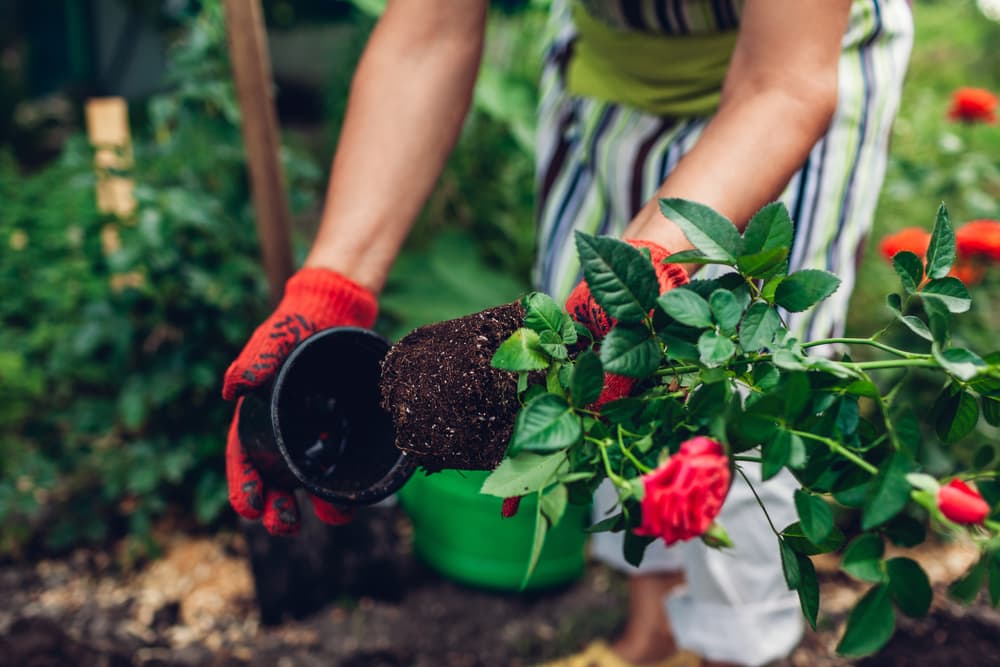
“The rule is, the bigger the container, the better for the plant,” says Philip.
If you’re using bare-root plants, pot them up in November ahead of growing season.
If you’re using container-grown plants, you’ve got a longer window: October through to April should do the trick.
And if you’re unsure of the difference:
- Bare-root plants are grown in the ground then uprooted and prepared for sale. Soil is removed from the roots, making them fully visible – hence the name.
- Container grown plants are grown and sold in a container (shock!), leaving it up to the gardener to transplant them into a suitable container of their own.
Watering
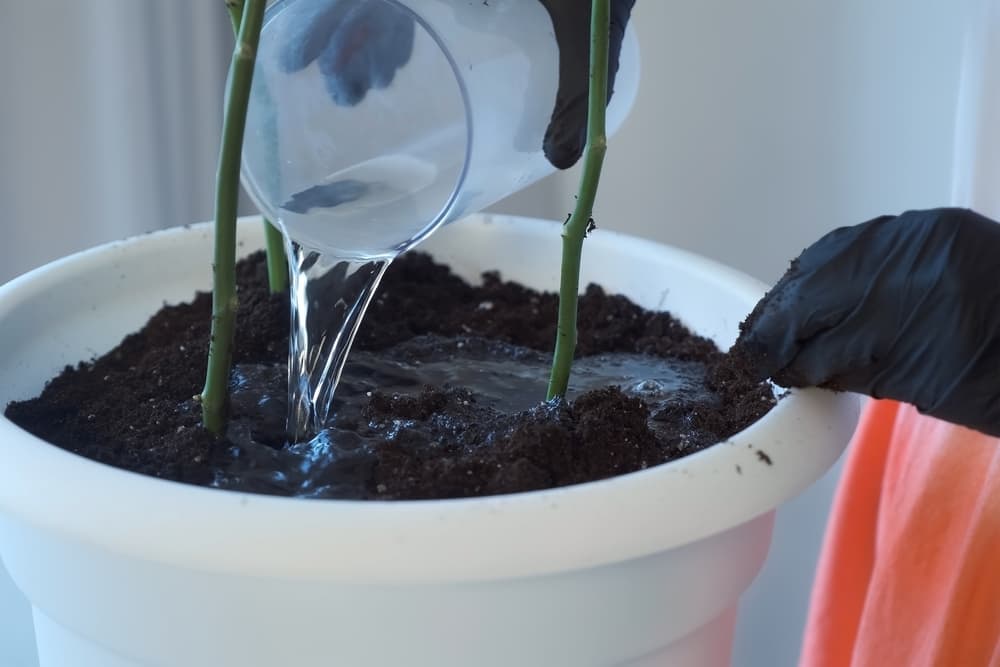
“Make sure you don’t let the compost dry out and keep your rose nourished,” says Colin.
Water your roses regularly, ensuring the soil stays moist.
“Roses grown in containers need more feeding and watering than those grown in the ground,” says Ben.
“Even when we have a lot of rain, if the rose is in full leaf and flower then the rain doesn’t get into the compost to the roots.”
Avoid over-saturating them however, as this can hinder rather than help growth.
Where possible, raise your pots above the ground to let the excess water drain out.
“I always preferred to water my pots in the morning rather than the evening, so they have the water in the day when they need it,” suggests Philip.

You can use bricks, pot feet, or any other secure base to do this.
Take a look underneath next time you water to check that the runoff escapes the soil.
Fertilising
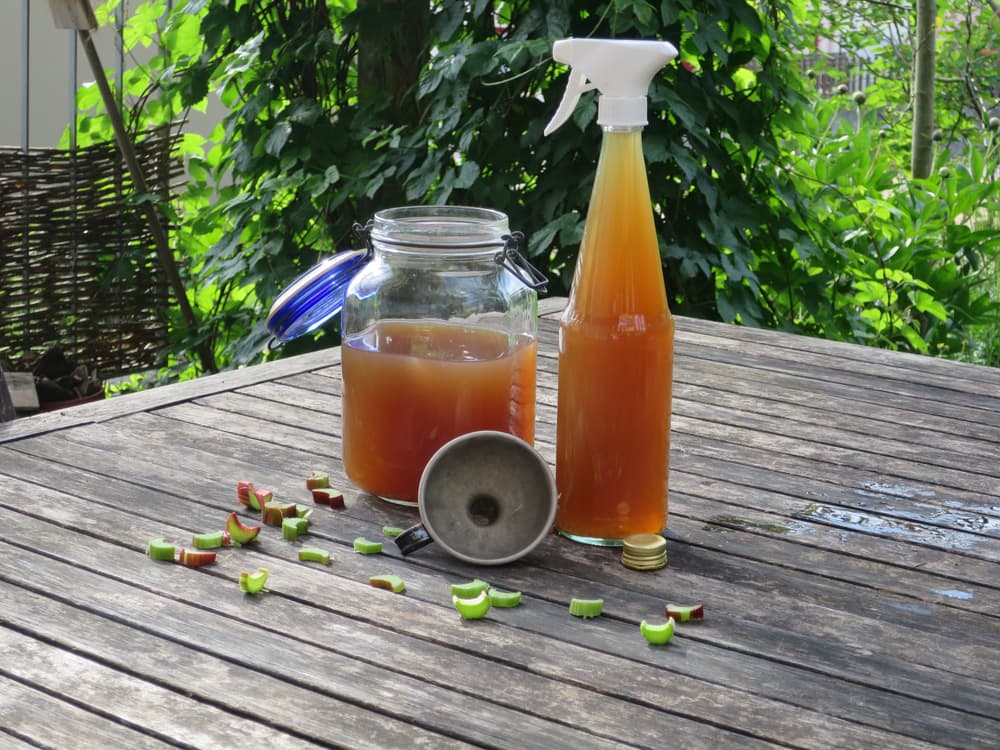
Roses like a fortnightly glug of liquid fertiliser in spring or summer.
This will help them to grow strong and sturdy, and will encourage vibrant colouration.
“We start to feed our roses as soon as the new leaf starts to come through and then continue this right through the growing season, about every two to three weeks,” shares Ben.
Add a dose of rose feed to the soil surface each spring for even more nutrition.
“Feed three times a year between spring and mid-summer with a proprietary granular slow-release rose feed,” says Chris.
You can top-dress the soil every second year, too – to do this, remove the top few centimetres of soil and add a new, fresh layer in its place.
Keep in mind that roses are particularly hungry customers and will do best when fed frequently and adequately.
Repotting

With the larger varieties of rose mentioned above, you may need to repot every few years to prevent their root systems from becoming cramped.
When this is required, use a larger pot with all new compost.
Pruning
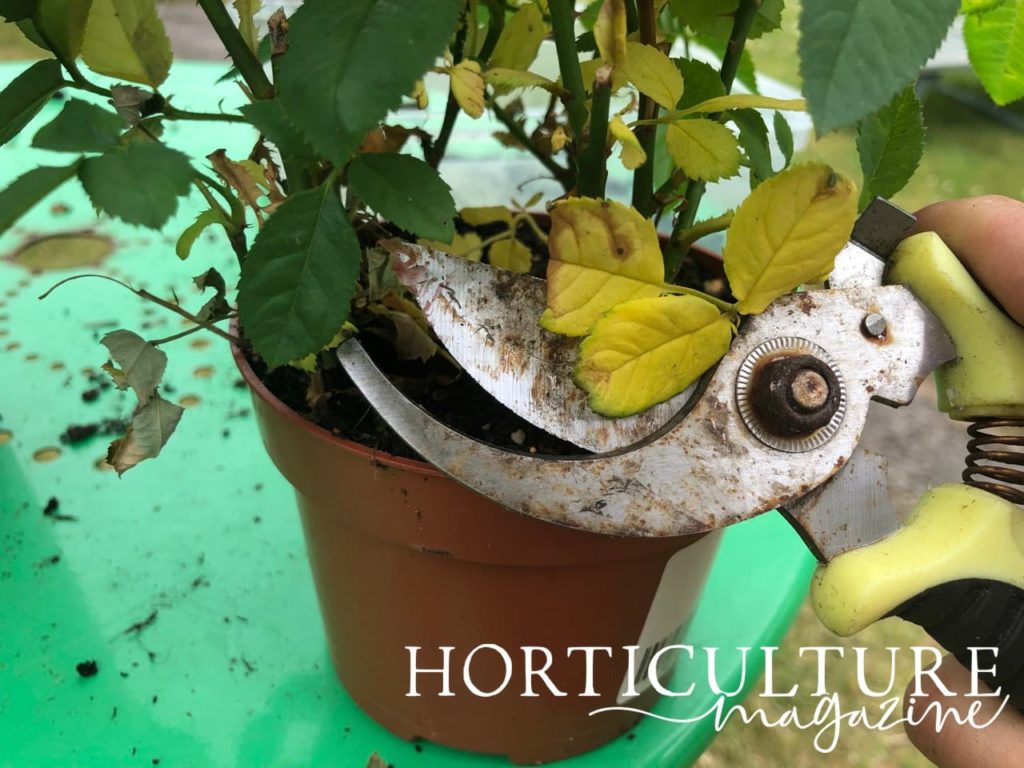
Each rose type has different pruning requirements and attempting a whistle-stop tour risks omitting their specific needs.
So instead, we’ll refer you to the instructions that accompany each variety you buy.
Taking care to prune as required will give you stronger, healthier, and prettier roses, so this is something we recommend spending time familiarising yourself with.
Pests & Problems
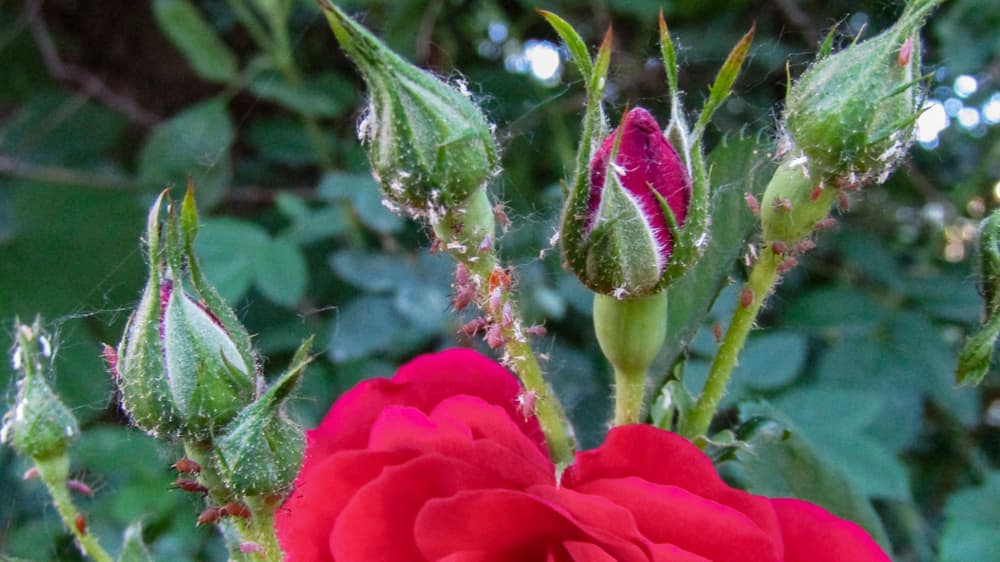
Roses are prone to attract aphids, so keep a vigilant eye out for green visitors and, god forbid, their small white eggs.
If you see either, remove them by hand and check to see whether they return. If so, seek a pesticide.
Powdery mildew is also a threat if your roses get too dry.
Ensure frequent watering, and if possible keep soil in the shade while the plant is in the sun.

Also, be sure to water the soil directly rather than the whole plant.
